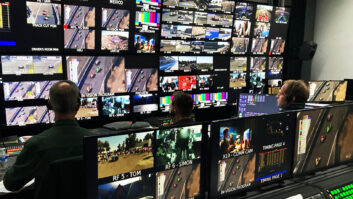The pandemic changed how we do lots of things — work, shop, dine, communicate. In virtually every case, it was a computer network, including the public internet, that allowed for digital transformation.
To be fair, a lot of this digital transformation was already underway when Covid struck. But with knowledge workers, teachers, creators, and others suddenly confined to home offices, or safely spaced throughout buildings, adapting network technology to existing workflows accelerated. Now, even with restrictions lifted, this change is here to stay. We see this within education, with interest in online education continuing to grow in the EU.
The same thing is happening in media production. When social distancing became necessary, television shows, sporting events, performances, conventions, even studio recordings were upended. Newscasts were delivered from home offices; sports commentators offered insights miles from the action; and an untold number of talks, keynotes, and panel discussions were delivered to audiences at their computers. And IP networks enabled it all.
The dawning of AV over IP
That’s no small feat when it comes to media workflows, which require moving vast amounts of audio and video data from point to point. So vast is the data that not long ago, moving media, such as b-roll for a documentary, required copying it to a physical device, like an external hard drive, and hand-delivering it to an editing studio.
Today, however, standards-based, internet protocol (IP) networks have flipped media workflows on their heads and changed the way audiovisual experiences are created and delivered. Cameras and microphones can now sit directly on a network; as can speakers, monitors, mixing consoles, digital signal processors, and media servers. High-capacity, gigabit networks have made sneakernets obsolete.
And it’s not just in service of socially distant, remote production. Building media workflows around IP networks offers flexibility, scalability, and ease of use in all situations. No more purpose-built, legacy AV cables or interfaces, no distance limits. If anything, running AV-over-IP saves both money and complexity.
AV over IP in the real world
The use of AV over IP has been popular for some time in audio-based settings. Just before the pandemic,the University of Strathclyde revamped their audio networks to use similar AV-over-IP technology. As the pandemic dawned, they used the Dante network to link lecture theatres to remote video communications, and to connect theatres together to help maintain social distancing by spreading students across multiple rooms as overflow spaces.
Now, high-definition video is part of the AV-over-IP equation. Not just the Zoom-style videoconferencing that became commonplace during the pandemic, but broadcast-quality, video-plus-multichannel-audio that is the backbone of media production. Delivered over a single wire, it’s the type of network-based workflow that can now support high-quality video collaboration across hundreds of offices in the corporate space, or rich, virtual learning across myriad classrooms and campuses in education.
The benefits of IT, but for AV
Delivering audio and visual content over an IP network affords the manageability and security that organisations already expect from their information technology networks. Yes, there are different ways to enable AV-over-IP workflows, but the key to helping production teams see real value from AV-over-IP is interoperability. It’s not enough to build an AV-over-IP link for connecting a few critical systems. Teams need to be able to plug in any of thousands of audio and video devices, add them easily to their workflow, and get down to creating.
That’s how production workflows really change for the better; how a studio in London with its favorite equipment and a studio in Berlin with its go-to gear can collaborate over a single network and work in real-time on a show, presentation, podcast, album, you name it. The pandemic forced production teams to adjust. AV-over-IP networks offered a new, better future.







